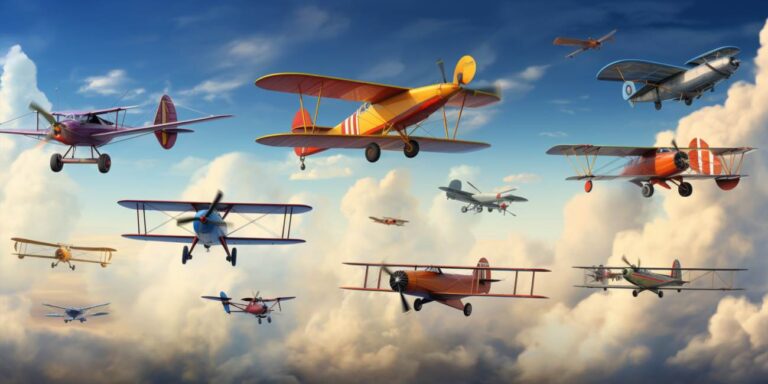Let’s begin our journey with commercial aircraft, the giants of the sky that ferry passengers across continents. The Airbus A380, with its double-deck layout, redefines luxury in air travel. In stark contrast, the fuel-efficient Boeing 787 Dreamliner showcases advanced materials and aerodynamics, providing a glimpse into the future of aviation.
For those fascinated by military might, fighter jets take center stage. The F-22 Raptor, equipped with stealth technology, epitomizes air superiority, while the versatile Lockheed Martin F-35 Lightning II serves various roles, from ground attacks to reconnaissance.
Now, shifting gears to the realm of private aviation, the business jet category offers a seamless blend of comfort and speed. The Gulfstream G650, known for its ultra-long range, caters to executives covering vast distances, while the Embraer Phenom 300 excels in the light jet segment, perfect for shorter trips.
Helicopters, often overlooked, constitute a distinct category of aircraft. The Bell 407, a versatile single-engine chopper, finds applications in everything from emergency medical services to law enforcement. Meanwhile, the AgustaWestland AW101, a multi-role helicopter, serves military and civilian needs alike.
Unmanned Aerial Vehicles (UAVs), commonly known as drones, have revolutionized various industries. The DJI Phantom series, consumer-oriented drones, have made aerial photography accessible to enthusiasts, while the MQ-9 Reaper stands as a military UAV with surveillance and strike capabilities.
Exploring the niche of experimental aircraft unveils the Rutan Long-EZ, a homebuilt marvel known for its efficiency and distinctive canard design. On the other end of the spectrum, the Northrop Grumman B-2 Spirit, a strategic bomber, showcases groundbreaking stealth technology.
Now, let’s delve into the realm of vintage aircraft, where classics like the Supermarine Spitfire and the P-51 Mustang evoke a sense of nostalgia and admiration. These iconic planes, once symbols of wartime heroism, now grace the skies as revered relics of aviation history.
In this kaleidoscope of different kinds of aircraft, each machine tells a unique story of engineering prowess, pushing the boundaries of what is possible in the boundless expanse above us.
The main different types of aircraft
Modern aviation boasts a diverse array of aircraft types, each designed for specific purposes and functionalities. From nimble general aviation planes to behemoth jumbo jets, the world of flying machines is as varied as it is fascinating.
At the heart of this airborne symphony are fixed-wing aircraft, the most common type. These are further categorized into several subtypes, such as airliners, which ferry passengers across the globe, and general aviation planes used for personal or business travel. Gliders, on the other hand, harness the power of updrafts and thermals, relying on the pilot’s skill to navigate the skies without an engine.
Contrasting the fixed-wing family are rotary-wing aircraft, which include the ever-iconic helicopters. Renowned for their ability to hover and perform intricate maneuvers, helicopters play crucial roles in areas like search and rescue, medical transport, and military operations. Their rotating blades provide the lift needed to ascend vertically, setting them apart from their fixed-wing counterparts.
Delving into the world of military aviation unveils a spectrum of specialized combat aircraft. These include fighters, designed for aerial combat and high-speed interception, and bombers, which deliver payloads to strategic targets. The versatility of multi-role aircraft allows them to adapt to various missions, seamlessly shifting between air-to-air combat and ground attacks.
For those intrigued by the cutting edge, experimental and unmanned aircraft break conventional molds. Unmanned aerial vehicles (UAVs), or drones, serve a myriad of functions, from surveillance to package delivery. Experimental aircraft push the boundaries of aeronautical engineering, testing novel technologies and designs that may shape the future of aviation.
Now, let’s explore the fascinating world of vertical takeoff and landing (VTOL) aircraft. These marvels include tiltrotors like the V-22 Osprey, capable of taking off vertically and then transitioning to horizontal flight. VTOL jets, such as the iconic Harrier, can hover and maneuver with great agility, making them invaluable in military applications where traditional runways are scarce.
As we navigate the skies of aviation diversity, we encounter commercial spaceplanes, an innovative intersection of aerospace and space exploration. These vehicles aim to provide cost-effective and routine access to space, promising a future where space travel becomes as routine as a commercial flight.
The most popular business jets models
When it comes to business jets, the aviation industry boasts an impressive array of options, with some of the most coveted models being the Cessna Citation, Gulfstream, and Bombardier. These three giants dominate the skies with their cutting-edge technology, luxurious interiors, and unparalleled performance.
The Cessna Citation series has long been a symbol of reliability and versatility in the business aviation world. Renowned for their efficiency and cost-effectiveness, Cessna Citation jets are a popular choice for both small and midsize businesses. The Citation X, with its exceptional speed and range, stands out as a flagship model, providing executives with a means to reach their destinations swiftly and in style.
On the other hand, Gulfstream has carved its niche by delivering opulence and sophistication at 40,000 feet. The Gulfstream G650 is a marvel of engineering, offering a spacious cabin, state-of-the-art technology, and a range that allows for non-stop transcontinental flights. It’s not just a jet; it’s a statement of prestige and luxury.
Stepping into the realm of large-cabin, long-range business jets, Bombardier takes the spotlight. The Bombardier Global Express series, with its impressive Global 7500 model, redefines the concept of ultra-long-range travel. Passengers are treated to a sumptuous interior, featuring customizable layouts that cater to the most discerning tastes.
Comparing these giants, the Cessna Citation excels in its adaptability and accessibility, making it a staple for businesses seeking efficiency. Meanwhile, Gulfstream positions itself as the epitome of luxury, ensuring that every flight is an experience in grandeur. Bombardier, with its Global Express series, combines the best of both worlds, offering range and lavishness on an unparalleled scale.
Let’s break down some key specifications to better appreciate the distinctions. In terms of speed, the Cessna Citation X is a speed demon, reaching Mach 0.935, making it one of the fastest civilian aircraft. The Gulfstream G650, while not as speedy, compensates with a longer range, capable of covering 7,500 nautical miles. Meanwhile, the Bombardier Global 7500 takes the crown for range, boasting an impressive 7,700 nautical miles.
Turning our attention to interiors, the Cessna Citation models focus on practicality and comfort, ensuring a productive environment for business discussions. Gulfstream’s commitment to luxury is evident in its cabin designs, featuring top-tier materials and meticulous craftsmanship. Bombardier’s Global Express series strikes a balance, offering customizable layouts that cater to both work and leisure, making it an ideal choice for business executives who demand versatility.
As we navigate the skies of business aviation, these three juggernauts – Cessna Citation, Gulfstream, and Bombardier – continue to shape the industry’s landscape. Each with its distinctive strengths, they cater to the diverse needs of business leaders, making a statement not just in the business world but in the vast expanse of the blue above.
Military aircraft fighters and bombers
Military aviation has evolved over the years, with advanced fighter and bomber aircraft playing a pivotal role in modern air forces. Among the standout performers are the F-16, F-15, Eurofighter, and Tornado, each showcasing unique capabilities.
The F-16 Fighting Falcon, often dubbed the “Viper,” is a multirole fighter jet renowned for its agility and versatility. Introduced in the late 1970s, the F-16 has become a staple in numerous air forces globally. With its compact size and a single-engine design, it excels in dogfights and ground attacks. The F-16’s advanced avionics and radar systems further enhance its combat effectiveness.
On the other hand, the F-15 Eagle stands out as an air superiority fighter, dominating the skies since the 1970s. Its exceptional speed, range, and firepower make it a formidable force. The F-15’s design emphasizes aerial combat, and its ability to carry a diverse array of missiles and bombs ensures its effectiveness in various scenarios.
The European collaboration produced the Eurofighter Typhoon, a state-of-the-art multirole fighter. Known for its agility and advanced technology, the Eurofighter is a result of combined efforts from Germany, Italy, Spain, and the United Kingdom. Equipped with cutting-edge avionics and a sophisticated radar system, the Eurofighter excels in both air-to-air and air-to-ground missions.
Stepping into the realm of bombers, the Tornado has made its mark as a versatile and reliable aircraft. Originally developed as a Panavia project involving the United Kingdom, Germany, and Italy, the Tornado is a twin-engine, variable-sweep wing bomber. Its adaptability allows it to perform a range of roles, including low-level penetration attacks and long-range strikes, showcasing its strategic importance.
Comparing these iconic aircraft brings out their distinct features. While the F-16 and F-15 focus on agility and air superiority, the Eurofighter stands out as a technologically advanced multirole platform. Meanwhile, the Tornado takes on the role of a versatile bomber with its variable-sweep wings and multi-nation collaboration.
As technology continues to advance, these aircraft remain at the forefront of military capabilities, proving their worth through decades of service. Whether engaging in dogfights, patrolling airspace, or executing precision strikes, the F-16, F-15, Eurofighter, and Tornado continue to shape the landscape of modern aerial warfare.
See also:
- Which aircraft has the longest range: exploring the limits of modern aviation
- What was the first mig aircraft: a history of soviet fighter jets
- What is military aircraft: their role and capabilities explained
- Which country created the first operational jet aircraft: overview of jet technology development
- How many aircraft in the world – the surprising number of planes around us





